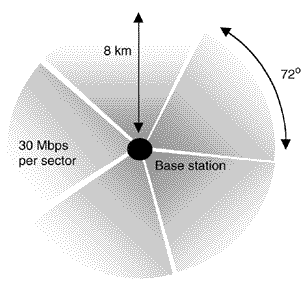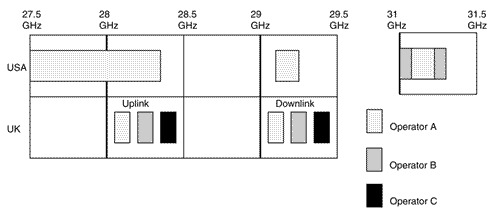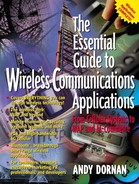Wireless Local Loop
The greatest potential for fixed wireless is in the local loop or last mile, the link from a customer's home or office to an ISP. It is the most efficient way to roll out communications services quickly. Transceivers can be installed in as little as an hour, compared to the several weeks taken to dig the ground and lay fiber-optic cable.
Fixed wireless comes in two broad varieties: point-to-point and multipoint, shown in Figure 11.1. Of the two, the latter is overwhelmingly the most useful for wireless local loop (WLL). It enables many customers to be connected to a single central transceiver, just like a mobile system. Some multipoint technologies are even deployed in a cellular pattern, though they usually save spectrum by putting gaps between cells. They can do this because every user has their terminal pointed permanently at one base station, removing the need for handoffs. Dead zones are also less important. People buying a WLL system care only whether it reaches their home or office, not whether it can be used worldwide.
Figure 11.1. Point-to-point and multipoint fixed networks

The disadvantage of a multipoint system is that, as with a mobile network, the total bandwidth is shared between all users in a cell. A point-to-point system provides a dedicated link, equivalent to a wire. Multipoint also tends to be asymmetric, as some systems were originally developed for television broadcasting, while point-to-point links are always symmetric.
The systems described here and summarized in Table 11.1 are all digital, aimed at providing high-speed Internet access. However, multipoint wireless over the local loop is not a new idea. Analog radio systems have been around for decades and are still used in many parts of the world. In the late 1990s, Eastern European governments installed them as a temporary measure, because they could not keep up with the demand for new telephone lines.
Though America is famously backward in mobile technology, it leads the world in WLL. In part, this is because the U.S. is a large, sparsely populated country, which has traditionally relied on fixed wireless to reach remote areas. Another reason is that the FCC placed a greater emphasis on competition in the local loop, a policy also apparent in its becoming the first country to pass laws requiring that telcos let competitors use their copper networks. There is only a limited amount of radio spectrum available, and some of what Europe uses for mobile, the U.S. uses for fixed.
| System | Frequencies | Shared Capacity | Licensed? | Cell Radius |
|---|---|---|---|---|
| Spread Spectrum | 2.4 GHz | 11 Mbps | No | 8 km |
| MMDS | 2.1–2.7 GHz | 36 Mbps | Yes | 45 km |
| LMDS | 28–31 GHz | 155 Mbps | Yes | 8 km |
Spread Spectrum
The most popular wireless local loop systems use the ISM (Industrial, Scientific, and Medical) frequencies around 2.5 GHz, the same as many wireless LANs. Indeed, most systems are actually based on the IEEE 802.11 standard, using DSSS (Direct Sequence Spread Spectrum) and CDMA.
The advantage of the ISM band is that no license is required, theoretically enabling anyone to set up their own network. Conversely, everyone else might do the same. The 802.11b standard is supposed to offer up to 11 Mbps, but was designed for relatively controlled, indoor environments, not for the wide area. As well as other 802.11 networks, long-distance links using ISM are subject to interference from HomeRF, Bluetooth, microwave ovens, and other users of the band.
To improve quality and reduce interference, many manufacturers of spread spectrum equipment add their own proprietary twist to the 802.11 standard. This means that the equipment sold by different companies is often incompatible—every node of a network must use the same type.
Proprietary systems are usually undesirable in the telecom and computer industries because they lock customers into a specific vendor, but this is less important for fixed wireless. A point-to-point link only has two ends anyway, while receivers for multipoint systems are usually bought in bulk and installed by operators. AT&T has even developed its own patented ISM system based on OFDM (Orthogonal Frequency Division Multiplex access), the emerging technology that may be used in 4G systems.
Although unlicensed worldwide, most governments do still place relatively strict controls on ISM radiation for health and safety reasons. This restricts its range to no more than about 8 km. Because the threat of interference increases the further that the signal travels, most operators use cells smaller than this. There is no real minimum cell size, so they can be made smaller indefinitely as operators sign up new customers.
Most people who deploy ISM spread spectrum systems find the actual throughput to be about 2 Mbps to 6 Mbps, which for a multipoint system is shared between all users in a cell. This might seem to cut capacity drastically, but operators have found that they can still use it to offer high-speed Internet access. A typical system might aim to give each user 256 kbps, which is ten times the speed of a dial-up modem. Even under the worst case (2 Mbps), up to eight customers could simultaneously download files at this speed, and far more could be online.
MMDS
Multipoint Multichannel Distribution System (MMDS) was developed in the 1970s as a television broadcast system. It was intended to compete with cable TV, carrying analog channels over a distance of up to about 45 km. This was shorter than the usual UHF and VHF channels, supposed to allow more local programming of the type that is sometimes carried by cable operators.
The FCC originally licensed only two 6 MHz channels, at frequencies starting from 2150 MHz, the same part of the spectrum that the ITU later wanted to use for 3G mobile. It later added another 31, from 2500 to 2672 MHz. Only 11 of these have actually been auctioned. The remaining 20 were retained by the FCC for what it calls the ITFS (Instructional Fixed Television Service).
The channels are shown in Figure 11.2. They are grouped into quartets (with one triplet), and the FCC originally planned to sell each to a separate operator. However, it eventually auctioned all 13 as a single lot. ITFS was intended for public service broadcasting, but is often leased to TV operators on the condition that they broadcast at least 40 hours of educational programming per week.
Figure 11.2. FCC spectrum allocation for MMDS

MMDS proved unpopular as a television technology in the U.S., though it is used for this purpose in many other countries, including Mexico and Australia. Its deployment further afield was held back by the incompatible television systems of many countries. For example, Europe's analog TV channels use a system called PAL (Phase Alternating Line), which has a higher resolution picture than the NTSC (National Television Systems Committee) standard of the U.S. The better quality images require 8 MHz of spectrum, so won't fit into the 6 MHz MMDS bands.
In 1998, the FCC approved MMDS use for two-way Internet access. The failed TV companies holding licenses were immediately snapped up by several carriers, including Worldcom and Sprint, whose Sprint Broadband service was the first to enter commercial operation. Designed for Web access, it is highly asymmetric. It initially offered download speeds of up to 5 Mbps and uploads at up to 256 kbps.
The main advantage of MMDS over spread spectrum is simply that its spectrum is licensed, so operators can be sure that no one will (legally) interrupt their services. Licenses also permit higher power transmitters, similar to a cellular base station. This similarity has encouraged some companies to experiment with limited mobility. It only really works while stationary, as there is no handoff mechanism, but most people access the Internet while sitting at a desk anyway.
If mobility can be provided, operators' licenses will seem an incredible bargain. UK operator Zipcom acquired its MMDS license for only $150 million, compared to the $9 billion paid by Vodaphone Airtouch for only a third as much UMTS spectrum. The frequencies are similar, so if MMDS is not successful, some countries may reallocate it to 3G.
If MMDS is to become a mobile technology, it will require open standards. Various vendors have formed a consortium to develop these, but so far every system is proprietary. To get away from MMDS's connotations as a failed cable replacement, the alliance has renamed the technology WDSL(Wireless Digital Subscriber Line). This is a rather confusing and inaccurate name, as it has nothing to do with the existing alphabet soup of DSLs, technologies used for sending high-speed data through ordinary phone lines.
LMDS
Local Multipoint Distribution System (LMDS) is the highest capacity multipoint technology yet devised. By using high frequencies and small cells, it can compete with expensive leased lines and provide all the fully integrated communications services. It has a peak data rate of around 155 Mbps, which leaves plenty of capacity to spare even if providing telephone, Internet, interactive television, and other services.
As the similar names suggest, LMDS and MMDS have much in common. The main difference is that LMDS uses higher frequencies, around 30 GHz. This means that more spectrum is available, but reduces the range and makes the signal more susceptible to fading. While other systems can be blocked only by severe rain or snow, LMDS requires an exact line of sight and is subject to interference from many weather phenomena, especially rain. This makes the cell size dependent on the climate—8 km is possible in ideal conditions, but operators in Northern Europe and many U.S. cities cannot make them much larger than 1 km to 2 km.
Each LMDS cell uses between four and six directional transmitters, each of which can provide a shared capacity of many megabits per second. The exact figure depends on how much spectrum the operator has been licensed, with some of the FCC's very generous assignments giving each sector up to 30 Mbps. With a distance of only 2 km, this means it can serve either densely populated areas, such as a city center, or a few customers with very high bandwidth demands. Figure 11.3 shows a typical cell, with a total capacity of 150 Mbps.
Figure 11.3. Five-sectored LMDS cell

Like MMDS, LMDS was pioneered and first licensed in the U.S. In an attempt to promote competition in the local loop, the FCC offered a total of 1300 MHz for the services, more spectrum than it has licensed to any other single technology. Even more remarkable, 1150 MHz of this was reserved for a single operator in each of the 493 regions. Incumbent RBOCs (Regional Bell Operating Companies) and cable operators were forbidden to bid for these, though they could buy the remaining licenses of only 150 MHz. The reduced spectrum means that they offer much lower capacity, similar to MMDS.
There was less spectrum available for LMDS in Europe, as many of the frequencies proposed for it were already used for satellite systems. Most countries did eventually license it, though in far smaller blocks than the U.S. As Figure 11.4 shows, the UK split its LMDS into three equal chunks of 224 MHz each, which all together are less than the single A license in the U.S. It also specified paired spectrum (112 MHz in each direction), which means that services have to be symmetric. This is unusual, as most U.S. operators are choosing to deploy asymmetric technology suitable for Web surfing. Both are available from vendors because, like MMDS, LMDS suffers from a lack of standards.
Figure 11.4. Spectrum allocation for LMDS

Competing Technologies
While mobile networks are by definition wireless, WLL has to compete with several wireline technologies, listed in Table 11.2. In most parts of the world and even the U.S., customers don't yet see this competition—many people would be grateful for any affordable way to access the Internet at high speed, regardless of the technology behind it.
Competition still exists, but at the operator level. ISPs that want to provide high-speed access without expensive leaded lines need to decide how they are going to reach their customers, which means evaluating the costs and benefits of each technology.
Fiber is the last-mile technology of choice for most people. Depending on the type and what is at the other end, it has a maximum data rate of anything from 2 Mbps to 10 Gbps, all of that two-way and dedicated to an individual customer. The actual glass cable is extremely cheap, but the tiny lasers needed to send and receive wavelengths of light are not. Still, where fiber is available and priced reasonably, there should be no need to consider WLL or anything else.
The problem with fiber is that for most customers it is not available. Negotiating rights of way is very expensive, and actually laying the cable is a disruptive and labor-intensive process. This pushes up prices to end users, making it cost-effective only for very heavy business users.
DSL (Digital Subscriber Line) sends high-speed data through ordinary copper phone lines. Voice calls use only relatively low frequencies, leaving a lot of spare bandwidth for other services. Many types of DSL are available, each of which offers a different capacity and distance. The most common is the relatively long-range ADSL (Asymmetric DSL). Most leave the lower frequencies alone so that they can coexist with regular phone service and even ISDN. It really does appear to offer something for nothing, but of course there are drawbacks.
The biggest barrier to DSL is that the copper lines are owned by phone companies, who would rather charge for expensive leased lines or fiber than offer cheap high-speed data to everyone. The U.S. passed laws in 1996 that forced the incumbent companies to let competitors offer service over their copper, a process called unbundling, but other countries have been much slower to do so. Even where unbundling has taken place, there are frequent disputes over charges, interference, and colocation, which means putting a competitor's equipment inside a telephone exchange. These can make many operators turn to wireless instead.
Like wireless local loop, DSL is highly distance-dependent: as distance increases, capacity goes down. However, the actual range of DSL can often be less than the stated maximum, because phone lines do not necessarily use the most direct route. While LMDS signals travel in a straight line from the user to the base station, DSL usually follows the paths of streets or overhead cables.
Cable Modems are sometimes offered by cable companies along with their TV service. They typically use the equivalent of one channel for data, with a maximum downstream capacity of 36 Mbps under NTSC and 48 Mbps under PAL. Upstream is around a tenth of this, and both are shared between all cable subscribers.The similarities between cable modems and MMDS are entirely deliberate. Before the WDSL monicker caught on, MMDS was sometimes referred to as "wireless cable," and some of the underlying standards are the same. In an attempt to create an open standard, the WDSL consortium has borrowed DOCSIS (Data Over Cable Systems Interoperability Standard), the protocol for encoding data into NTSC.
Powerline Networking is a new system that sends data through the electricity supply. Electricity is far more ubiquitous than telephony, so it offers even greater potential than DSL. Many areas of the world that don't yet have phones do have electricity, and most homes and offices in the West have many more electricity outlets than phone sockets. Another advantage over DSL is that the power cables are usually owned by companies who don't have a vested interest in preventing competition.
Unfortunately, powerline network is still in its infancy. One unresolved problem of particular interest to the wireless industry is interference, caused by the powerline's electrical and magnetic field. All wires carrying AC electricity emit some kind of radiation, but traditional power lines are at a very low frequency and data wires are at a low voltage. A powerline network combines high voltages with high frequencies, turning the electric grid into a high-energy radio transmitter.
Despite frequent claims that in the future we will think no more about interacting with the Internet than with the electricity supply, this scenario is still many years away. For the foreseeable future, networking will remain more difficult than plugging in a computer.
| Technology | Uplink | Downlink | Range |
|---|---|---|---|
| Fiber | 622 Mbps | 622 Mbps | 100 km |
| ADSL | 384 kbps | 2 Mbps | 6 km |
| ADSL | 2 Mbps | 24 Mbps | 0.6 km |
| Cable Modem | 384 kbps (shared) | 48 Mbps (shared) | No limit |
| Powerline | 2 Mbps | 2 Mbps | No limit |
| LMDS | 8 Mbps (shared) | 155 Mbps (shared) | 8 km |
| MMDS | 1 Mbps (shared) | 36 Mbps (shared) | 45 km |
